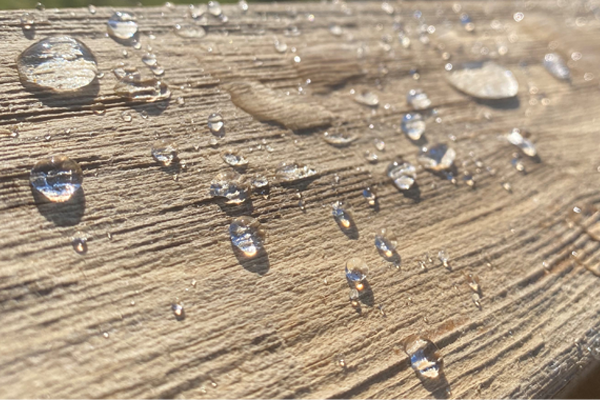
In the UK, our outdoor surfaces must endure a battering from the elements almost all year round from high levels of rainfall. One of the most prone surfaces to weathering is wood, which is why our experts have put together a complete guide on how to waterproof outdoor wood, so you can protect your timber surfaces no matter the weather.
Why is Waterproofing Outdoor Wood Important?
There are a multitude of things that can damage outdoor wood. However, the primary cause of damage to outdoor wood like many other building materials is moisture.
The problem with many outdoor building materials such as wood, brick, stone & concrete is that they are all porous, which causes them to absorb moisture. The more porous the material, the more water it can absorb and hold. Wood is one of the most porous building materials, so no matter whether you have a hardwood or a softwood building material, they will all allow moisture to enter the surface and cause it to become saturated.
The reality is, while wood is a natural mineral surface that grows outdoors, when used in building materials it can be more susceptible to damage than other mineral surfaces. Moisture once it is allowed to absorb into outdoor wood leads to a number of problems, namely rotting, shrinkage, organic growth and discolouration.
ROTTING
Rotting wood is a familiar sight in the UK, as the level of moisture that outdoor wood must endure here in the UK can be substantial. Rotting can be come in a range of forms, however it most commonly refers to 'wet rot' caused by a fungus that feeds off the timber. When the fungus attacks the wood, it eventually causes it to weaken and breakdown, causing what we know as rot. Any organic growth such as fungus requires high levels of moisture in order to bloom and grow, meaning the fact that wood can hold large amounts of moisture means rot can be a significant problem. Once the wood rot has taken hold of the wood, it will only worsen over-time until the source of the moisture is prevented and thus rot stops spreading. Even once the moisture is prevented, any sections of wood that have rotted away will likely need repairs made to make the surface sound.
SHRINKAGE
Unlike other mineral surface, wood has the tendency to go under a process of shrinkage and swelling, as moisture levels change over the seasons. When this movement occurs, it can cause wood to begin to warp and cause splits to occur in the wood. These splits allow more moisture to enter the wood and lead to further damage.
ORGANIC GROWTH
In the same way as fungus causes rotting, organic growth like moss, algae and lichens all grow on mineral surfaces that are high in moisture. This organic growth can negatively impact the natural beauty of the timber and leave it looking highly weathered. Algae especially once it develops on the timber can leave large green patches that can leave any outdoor wooden surfaces looking neglected. While generally not a problem for the integrity of the wood, growth such as moss can also lead to some damage to the timber.
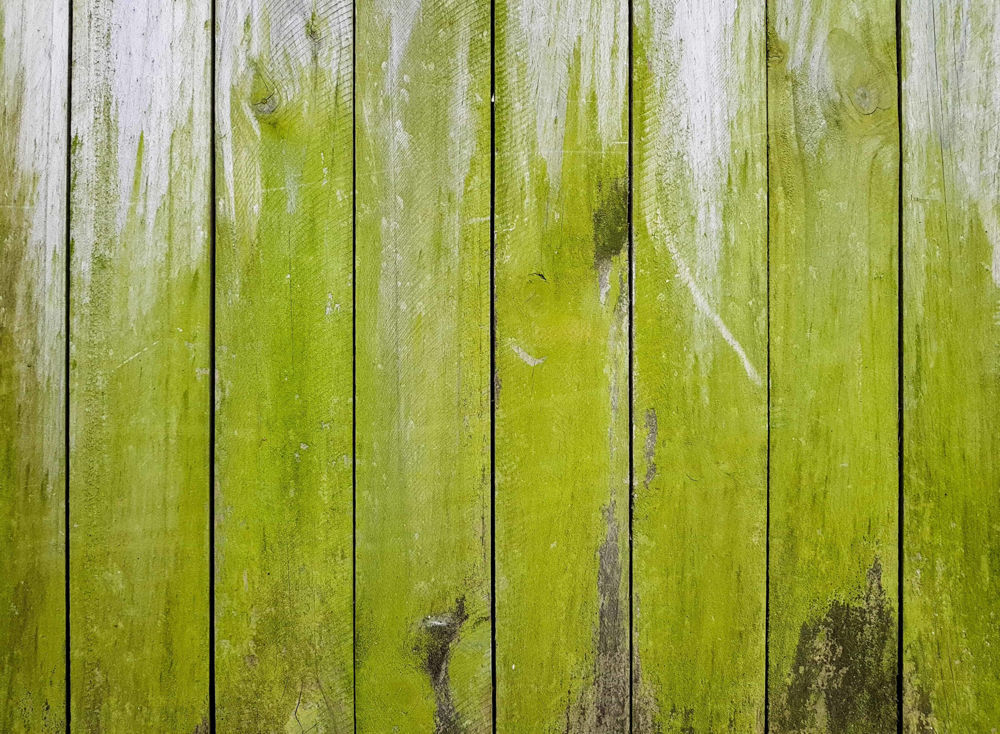
DISCOLOURATION
Aside from organic growth on timber, when the timber becomes damp with moisture, it will discolour and darken the wood. When some of the wood is more saturated than other parts, it leaves a patchy look to is less than desirable.
Furthermore, aside from moisture, wood can also discolour due to the elements however this time in the form of UV rays. UV rays cause what is known as 'silvering', where wood becomes bleached and loses its natural pigment.
How To Waterproof Outdoor Wood
CHOOSING THE RIGHT TREATMENT
In order to waterproof outdoor wood and prevent it from absorbing moisture, it is important to provide the wood with added protection.
There are a wide variety of wood products on the market which all offer varying qualities. Products that are specifically designed for outdoor wood include wood paints, wood oils, wood sealers, wood waterproofers and wood stains. These types of products all offer varying levels of protection from moisture, which can cause a fair bit of confusion amongst homeowners.
- Wood paint - this is an opaque paint that completely covers the grain of the wood with a coloured finish
- Wood stain - this is designed to maintain the grain of the wood while providing it with added colour, often used on rough sawn timber such as fencing
- Wood oil - provides full character and enhances the natural beauty of the wood while providing adding a hard, durable finish to the surface of the wood
- Wood waterproofer - a wood waterproofer is an invisible treatment that creates a water repellent finish on exterior timber that reduces water absorption, while also remaining highly breathable by chemically bonding to timber
- Wood sealer - a wood sealer similar to a wood waterproofer in the way that it offers an invisible water repellent finish on exterior timber, creating a protective film on the wood that 'seals' the wood
While all wood products are designed to offer different finishes, they also vary in terms of their waterproof ability and breathability. Firstly, to be waterproof, a product must be water repellent. The terms 'weatherproof' or 'weather-resistant' are often used to describe exterior products, however this often means they are not fully waterproof and will uptake some level of moisture. Even products that are waterproof at first can lose this waterproofing ability in a matter of years or even months when they begin to weather. For this reason, the life span of a product is a key indicator of its ability to waterproof as water is the primary cause of wood product failure.
When it comes to breathability, this is just as important as waterproofing when it comes to protecting outdoor wood. Breathability refers to the ease of which water vapour can pass through a substrate. The higher the breathability, the more water vapour can naturally breathe out of a material and the drier it stays. If a low breathability coating is applied to wood, it will trap moisture within the timber, causing it to build-up and saturate the wood. Eventually, after rot and other moisture related problems are caused, the low breathability coating will fail, leaving the wood unprotected once again.
If you want to achieve a coloured finish and change the hue of the wood, a wood paint, wood stain or wood oil is your best option. While these products are primarily designed to change the aesthetic of the timber, they will offer some level of waterproof protection to any outdoor wood. Wood oils are available in both coloured and clear versions, however even the clear versions will darken the timber once dry as they begin to nourish the wood.
If you want to maintain the natural colour of the wood but simply want to protect it from weathering, you can choose between a wood waterproofer or wood sealer. When it comes to offering long-term invisible waterproof protection, Emperor Exterior Wood Waterproofer was specifically designed. Emperor Wood Waterproofer uses nano-technology to chemically bond to natural outdoor wood. By chemically bonding to the wood, it does not create a film or seal on the surface meaning the breathability of the wood is not impacted but also that there is no change in appearance. As well as this, it creates what is known as a 'super hydrophobic' surface on the timber that causes water to form beads on the surface, that simply fall off the wood before it absorbs in. This means that bare wood stays looking completely natural but is given water repellent properties to reduce rotting, discolouration and green growth.

In independent testing conducted by as UKAS accredited laboratory, Emperor Exterior Wood Waterproofer was found to withstand harsh weather conditions for 25 years with no change in performance or appearance, passing the EAD 040287-00-04:2018 - 25 year hygrothermal performance Quality Standard. This high durability is thanks to there being no film to become weathered over-time due to the way the product chemically bonds. It also comes with a 10 year manufacturer's guarantee.
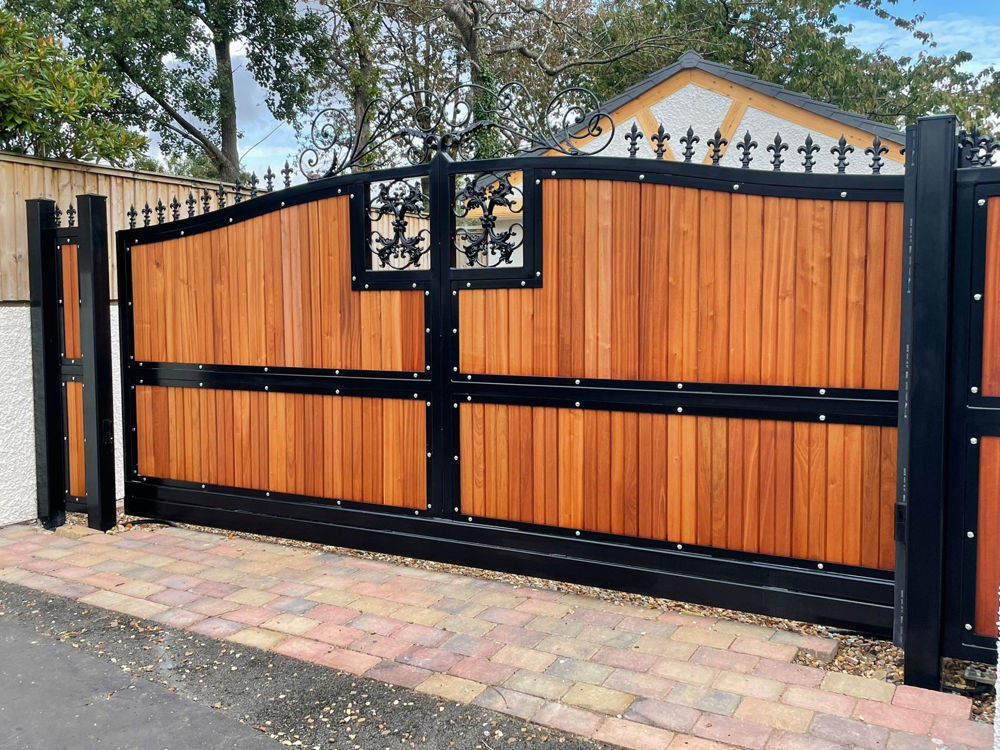
PREPARATION
Once you have selected the waterproof wood treatment that best suits what you require, it is important to prepare the timber. Preparation is the single most important part of any decorating process, meaning it can make or break your project. Taking time now to make sure the wood is sound and clean will pay double in the long run.
The first step is to remove any dirt, debris or organic growth from the wood. This ensures that once you apply any product to the wood, it can perform without anything hindering it. The cleaning required will depend on the extent of the dirt on the wood, as some timber will be cleaner than others. On decking & other timber that will gather dirt easily, a power washer may be required. On newer timber, a brush can remove any dust and dirt away from the surface. This is also an opportunity to sand the timber slightly to remove any deep ingrained dirt.
The second part of the cleaning process is to apply a fungicidal cleaner such as Emperor Exterior Cleaner to the timber. This kills any fungal growth such as moss, lichens or algae so that once you waterproof the wood, this fungus cannot re-appear. Simply apply the fungicidal cleaner to the wood by brush, roller or pump-sprayer and leave it to dry for two hours. After this period, you can then simply rinse the cleaner off the wood to remove any residue that may be visible.
Once the wood is clean, it is time to check whether it is all sound so you can make any repairs that are required. If you have any holes or rotting wood, this can compromise the waterproofing of the timber. Remove any areas of wood that are rotting and fill these using an exterior wood filler. If you are using a clear treatment like Emperor Exterior Wood Waterproofer, ensure you find a filler that matches the shade of your wood, as this will be visible.
APPLICATION
The application of the product you are using will vary, as paints and stains are often two or three coat systems, while Emperor Exterior Wood Waterproofer is a one-coat system.
In the case of Emperor Exterior Wood Waterproofer, this can be applied using a low-pressure pump, brush or roller. Simply apply the treatment to the clean, bare wood at a coverage of 5m2 per litre. The thin milky liquid will simply soak the timber and absorb in as it dries. After 1-2 hours at 20°C, the treatment will have dried completely and will begin to repel water.
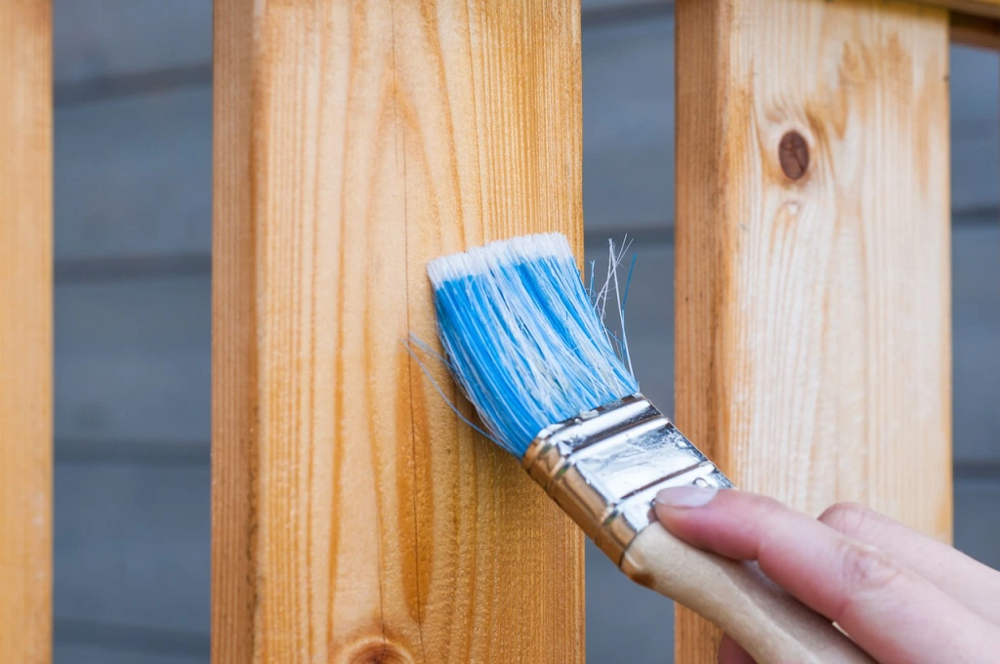
Frequently Asked Questions
Q. WHY DO DIFFERENT WOOD PRODUCTS HAVE DIFFERENT LIFE SPAN?
The life span of an outdoor wood product can vary widely due to a number of factors. The simple explanation for this is a wood products life span is dependent on its ability to resist weathering. The primary cause of failure in any outdoor treatment is its ability to keep water out, as moisture is what leads to the vast majority of problems with treatments. Heavily linked with this is breathability, as trapping moisture inside the wood will also cause damage. Having said this, even if a waterproofing treatment works at first, over a matter of time it can begin to worsen in performance due to it simply not being designed for long-term use. When evaluating the life span of a wood treatment, it is important to look for independent testing and to read carefully what conditions are applied to life spans, as sometimes life spans can be calculated on best possible conditions.
Q. WHAT OUTDOOR TIMBER SURFACE CAN BE WATERPROOFED
It does not matter what outdoor wood you have, waterproofing it is the best way to protect it and extend its life span. Emperor Exterior Wood Waterproofer can be used on wooden fencing, sheds, log cabins, cladding, decking, furniture. As long as the wood is bare, you can simply apply the product to the wood in order to provide it with quick and easy waterproof protection.
Be careful with some wood treatments as some paints and stains cannot be used on horizontal outdoor wood such as decking.
Q. IS THERE A COLOUR DIFFERENCE WHEN YOU WATERPROOF OUTDOOR WOOD?
When any natural wood becomes saturated, it can darken significantly. This is particularly the case with softwoods such as spruce and cedar. When you prevent this saturation, you maintain the natural hue of the wood and helps reduce the risk of any darkening, but also discolouration from organic growth.

A fence panel waterproofed with Emperor Exterior Wood Waterproofer compared to untreated fence panels.
Q. HOW DO I PREVENT NEW TIMBER FROM LOSING ITS COLOUR?
Even though in this country rainfall has the biggest impact on outdoor wood, UV degradation can cause problems even though we aren't known for the amount of sunshine we get! UV rays bleach wood causing 'silvering', where natural wood losing the strength of its colour over-time. Emperor Exterior Wood Waterproofer is UV resistant, meaning it prevents silvering much in the same way suncream prevents sunburn on human skin. This ensures the natural colour of the timber is protected and your wooden surfaces stay looking their best long-term.
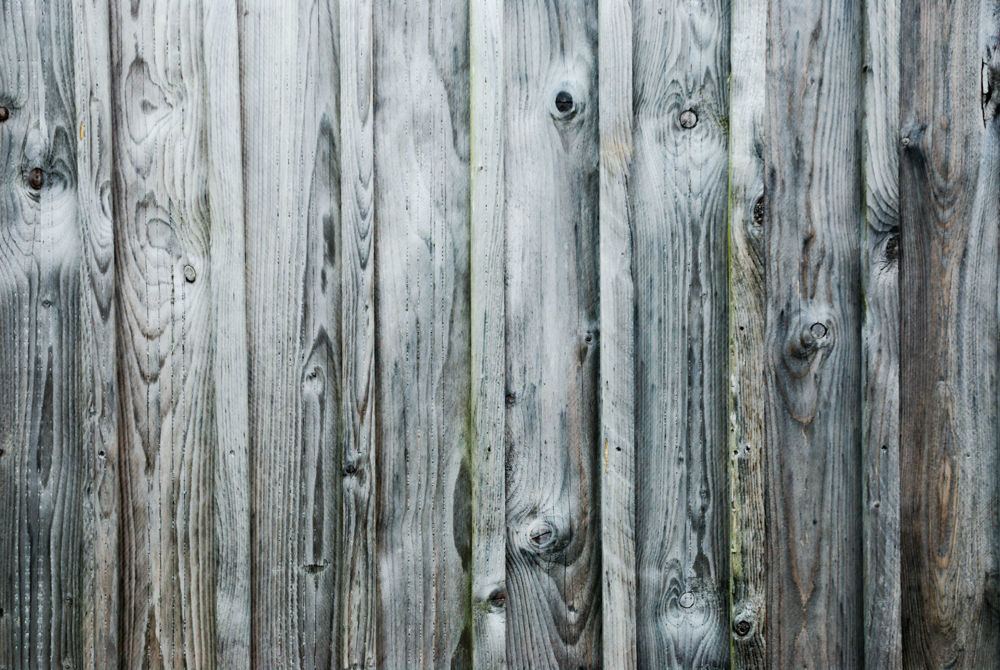
Outdoor wood that has discoloured and silvered over-time.
We hope we have answered any questions you may have had regarding how to waterproof outdoor wood. If you have any other questions, feel free to get in touch with our team of experts who are on hand to assist you. Contact them today by emailing info@emperorpaint.co.uk or calling them on 0161 509 9009. Alternatively, shop our range of exterior waterproofing treatments today and get FREE delivery on all orders.

